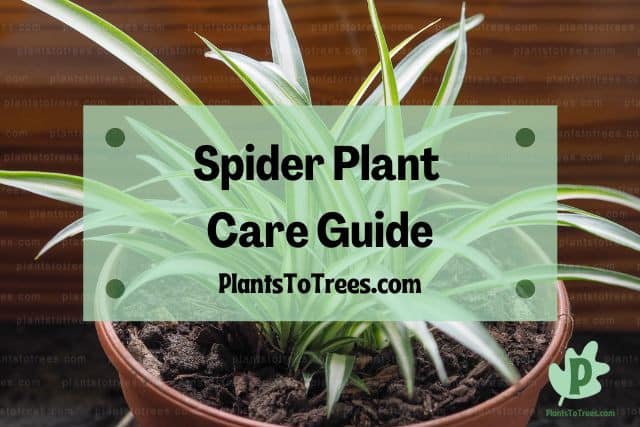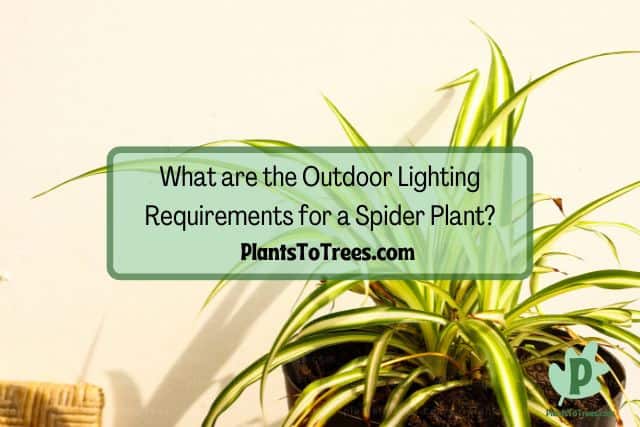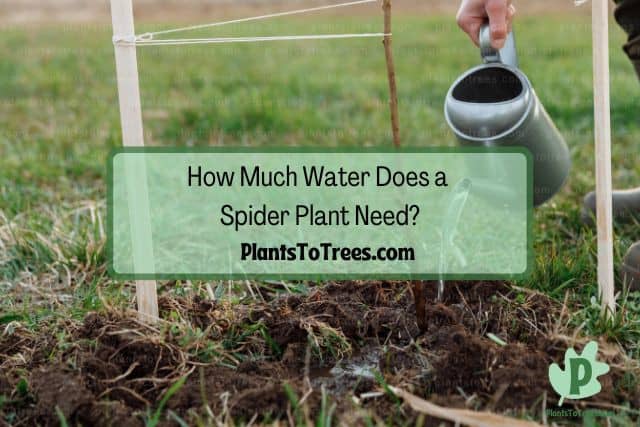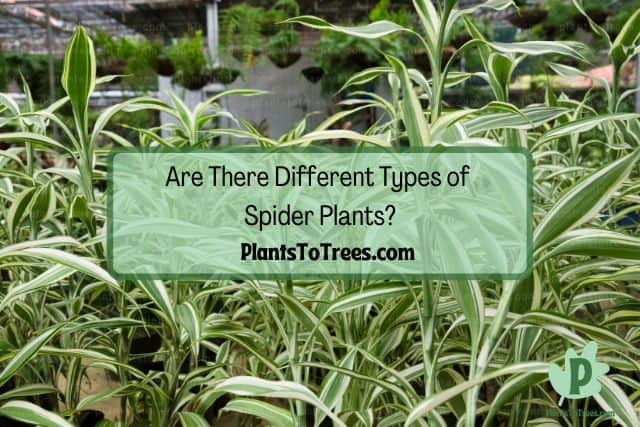Spider plants (Chlorophytum comosum) are named for this distinctive appearance. Their leaves are long and dense, they hang down in a manner that resembles the legs of a spider. One of the unique factors of the spider plant is the way that they grow. While it has one large plant, it also grows almost vine-like offshoots. Before your spider plant sprouts smaller plants, you’ll notice little white flowers. These off-shoots then sprout new spider plants of their own. This African plant is one of the more popular houseplants.

Spider plant care is rather simple. They are very easy plants to grow and care for indoors. Their ease of care is one of the reasons that they are such popular houseplants. When getting a spider plant, making sure that you have the right conditions will set you up for success.
The leaves of the spider plant vary depending on the type, but all of them have striking markings, making for a great contrast between the green of the leaves. Surprisingly enough, spider plants are part of the asparagus family. Now, while these plants may be low-maintenance indoor plants, the key to that is to start right and make sure that you are caring for all of your spider plant’s needs. Here are a few guidelines that you should follow when growing a spider plant.
Other Names of Spider Plant
Depending on what region you live in, oftentimes there are plenty of different names for plants. What you may think is the correct name may be a little different from what other people call a certain plant. When it comes to additional names, the spider plant is no different.
The spider plant is known by several different names. The spider plant’s scientific name is Chlorophytum comosum. The spider plant is also referred to as spider ivy, due to the shape of its leaves and how it grows. Similar to that, it is also called the ribbon plant.
You may also hear a spider plant being referred to as Anthericum, although this is a less common name for the plant.
Frost Tolerance and USDA Hardiness Zone of Spider Plants

When thinking of spider plants, most people think of them as indoor plants. The truth is that they make great outdoor plants as well. That is, if you live in the right climate conditions. Spider plants are native to South Africa. They are used to environments that are arid, but they also do well in humid environments. The leaves of the spider plant are able to absorb moisture from the air without becoming overwatered.
Spider p; ants grow in the USDA zones of 9 – 11. Your spider plants won’t grow year-round, they’ll grow more like a perennial. While they are hearty plants, if you live in a cooler climate and are planting your spider plants outdoors, there may be some issues.
When planting your spider plants outdoors when you live in a cool climate, make sure that there is no chance of frost around the corner. Spider plants have little to no tolerance for frost.
How Many Hours of Sunlight Does a Spider Plant Need?
Spider plants are plants that love sunlight. They originate in South Africa, where the conditions provide them with ample sunlight throughout the year. As spider plants are one of the most popular houseplants, people grow them all around the world. To help your spider plant flourish, taking into consideration just how much sun is needed, is key to your plant’s success.
Your spider plant needs between three and four hours of indirect sunlight a day. If your spider plant is getting less sunlight during certain months, it can still survive. You may notice, however, that the growth of your spider plant is stunted.
When growing your spider plant indoors, you have the flexibility of being able to move it to different locations. If you want a plant that will flourish, you can move your spider plant to a different spot depending on the season and how much natural light is available during the day.
Does a Spider Plant Need Direct or Indirect Sunlight?

The natural habitat of the spider plant is in South Africa. Because of this, spider plants are relatively hardy plants that do well in near desert conditions. When it comes to the proper lighting for your spider plant, these plants can tolerate a couple of different settings.
Spider plants do best when they are kept in bright, but indirect, sunlight. They can also grow in low light conditions. However, you will notice that the rate at which they grow is stunted. Spider plants do not do well if there is no natural light.
Without proper lighting conditions, the first thing that you will notice is that your spider plant will not grow as expected. Over time, if you continue to keep your spider plants in these lighting conditions, your plant will not be able to absorb enough nutrients from the sun and will slowly die.
You should not keep your spider plants in bright, direct sunlight. If your spider plants get too much sun, you will notice that the leaves on your plant begin to brown. Your spider plants may also begin to develop brown spots where the leaves have been exposed to direct sunlight for too long.
When deciding where to put your spider plants, one of the best places that you can put them is in a filtered but bright area.
Is a Spider Plant an Indoor Plant, an Outdoor Plant, or Both?
Spider plants are a plant that is native to South Africa. They are accustomed to arid conditions.
Spider plants can be both indoor and outdoor plants, but it depends on the environment that you live in. They are a plant that does not fare well when subjected to overwatering. When growing spider plants indoors, they are very easy plants to care for.
If you live in an environment that has frequent rain or experiences long periods of cold temperatures, growing your spider plant indoors is the right route for you.
What are the Indoor Lighting Requirements for a Spider Plant?
Spider plants have the great feature of being versatile plants. They can be planted both indoors and out and thrive, depending on if they are cared for properly. If you’ve got an indoor spider plant, placing it in an area with the right amount of light means that the end result will be a flourishing plant.
The best indoor lighting conditions for your spider plant is an area that gets bright, but indirect, sunlight for at least three to four hours every day. Spider plants can grow in low light conditions, but their growth will be slow and your plant will not be as strong.
When growing your spider plant indoors, just make sure that it is not placed in an area that has little to no natural light. You also don’t want to put it in an area that gets several hours of direct light. Both of these lighting placements will result in your spider plant dying. You will notice that the leaves begin to brown if they are getting too much sunshine. If your spider plant is not getting enough sunshine, you’ll notice that the leaves will begin to wither.
What are the Outdoor Lighting Requirements for a Spider Plant?

The great thing about spider plants is, depending on the environment that you live in, they can make a stunning addition to your outside garden. Spider plants, which are native to South Africa, can grow outside as perennials. There are two factors that you need to keep in mind if you want to have your spider plants flourish in your garden, and one of them is lighting.
Spider plants require indirect or filtered sunlight. You need to plant your spider plants in an area where they can get at least three to four hours of sunlight. Your spider plants will not fair well in areas of direct, long-term sunshine.
You’ll be able to tell if your spider plants are getting too much or too little sunlight. When your spider plant gets too much sun the leaves will begin to brown. You may first notice that your spider plant has brown spots that are developing on its leaves. Your spider plant’s leaves may also begin to be yellow.
What Soil Requirements Does a Spider Plant Need?
Soil is more important than you may think when it comes to growing healthy plants. Your spider plant absorbs nutrients from the soil. It also affects how your spider plant absorbs other things.
Spider plants require soil that is a light potting mixture. This way, water can drain faster, and you don’t run the risk of drowning or rotting your spider plant’s roots. You also want to look for soil that has added minerals in it.
How Much Water Does a Spider Plant Need?

Spider plants are natural to the rather arid climate conditions of South Africa. While they can grow in conditions around the world, both inside and outdoors, there are ideal conditions that are key to having a healthy spider plant that flourishes. That includes the amount of water that you are giving our spider plant.
Spider plants are a plant that requires less water than some popular houseplants. Your spider plant will only need to be watered once or twice weekly. If you water it too often, you will kill your plant. Spider plants do well in humidity, as they can absorb what water they want out of the air.
A good rule of thumb when watering your spider plant is to check the dryness of the soil. Do not water your spider plant unless the soil has had a chance to fully dry out. If your soil is constantly damp, you run the risk of killing your spider plant due to either overwatering or root rot.
Is My Spider Plant Overwatered? What are the Symptoms?
Although spider plants are a plant that is very easy to care for, it still has specific watering requirements that you need to adhere to if you want your plant to flourish. Spider plants are plants that do not need to be watered frequently. Between waterings, it is best to wait until the soil has fully dried out before you water your spider plant again.
One of the first ways to tell if your spider plant is overwatered is if you see yellowing leaves. Your leaves will begin to fade to a sickly yellow color and begin to droop. You’ll also notice changes around the stem of your plant. The base of your spider plant will be mushy to the touch.
Along with the change in texture, you’ll also notice that mold will begin to form around the base of your plant. This is a sign that your roots have begun to rot due to too much constant moisture in the soil.
You will also notice that your spider plant will begin to lose leaves. These aren’t the typical leaves that would fall off to make room for new growth. Both new and old leaves will begin to fall off if your spider plant is overwatered.
Your spider plant’s leaves will also feel different when you go to touch them. Rather than feeling healthy and firm, they may feel puffy and soft. This is because the leaves of your spider plant are absorbing too much moisture. With nowhere for that moisture to go, it floods areas of the plants, causing them to become waterlogged.
The first step to take if your spider plant is overwatered is to stop watering your plant immediately. Let your spider plant’s soil dry out completely before you water it again. Going forward, be sure to let your plant drain properly and reduce the frequency at which you are watering it.
Is My Spider Plant Underwatered? What are the Symptoms?
Spider plants are very hardy plants. When looking for them in the wild, you can find them in South Africa. They are easy plants to grow indoors and outdoors, depending on the climate and environment where you live. Spider plants are sensitive when it comes to watering. Both overwatering and underwatering can lead to your plant dying.
If your spider plant is underwatered, look at the leaves first. A spider plant that is not getting enough water will have leaves that are beginning to brown. If your spider plant is severely underwatered, when you touch the leaves, you will notice that they crumble easily.
If your spider plant is underwatered, you will also notice that the leaves begin to yellow and eventually brown. As opposed to overwatering, the changing leaves that begin to fall off will not feel soft and wilted but will be rather crunchy.
When looking at the stem of your spider plant, you will notice that your plant is underwatered when the stem begins to fade to yellow and begins to curl.
If your spider plant is underwatered, it’s important to begin slowly increasing its water right away. You want to do it gradually. Giving your plant too much water at once can shock it and cause it to die.
How Much Fertilizer Does a Spider Plant Need?

Fertilizing your household is an essential step in encouraging healthy growth. Depending on the type of houseplant that you’re growing, there are different times of year that you should apply fertilizer. When using fertilizer, remember that too much of a good thing can damage your plant. You don’t want to fertilize your plants too often.
Your spider plant needs fertilizer once or twice a month during its growing season. You want to apply fertilizer throughout the spring and summer months to keep your plant flourishing. You should use an all-purpose water soluble fertilizer or pellet fertilizer on your spider plant.
Fertilizing your spider plant will help it flourish year-round.
Spider Plant Diseases to be Aware of
Spider plants make great house plants because they are relatively hardy and easy to care for. The South African plants will flourish if cared for properly. However, one of the issues that your plants may face when growing them are diseases that can damage and kill your plants.
Spider plants are plants that do not frequently get any diseases. There are no common diseases that frequently impact the plant. That doesn’t mean that your plant is immune. Like any plant that is improperly cared for, it can suffer from root rot.
If you are overwatering your spider plant, or if you’ve used the wrong soil, your spider plant is at risk for root rot. Once root rot sets in, it will spread and lead to mold. Eventually, root rot will kill off your spider plant.
Depending on your climate and the environment in which you are growing your spider plant in, it may also fall prey to fungal rot on the leaves. This can be treated with fungicides. You can also trim any leaves or vines that are displaying signs of withering or wilting due to fungus.
Are There Different Types of Spider Plants?

While in the same genus of plants, many plants have several different varieties. These can occur naturally, or they can be the result of hybrid breeding. Hybrid breeding is done to take the attractive traits to form different plants and combine them to create a new plant. When occurring in nature, you can find different types of plants, depending on the environmental conditions. Over time, plants adapt to new conditions by evolving.
There are over 200 different types of spider plants that can be found across the world. While there are some types that are more commonly sought after, like indoor or outdoor plants around the home, there are plenty of lesser-known varieties as well.
A few of the most popular types of spider plants are the vittatum spider plant, the fire flash spider plant, the variegated bonnie spider plant, the Hawaiian spider plant, and the purple spider plant. All of these varieties are easy to grow and care for, making them a great choice for those who want low-maintenance plants, or those who are just beginning to explore their green thumb.
How to Propagate a Spider Plant
Propagation is an interesting process in plants. It’s where you grow a new plant from different parts of your mature plant. You can propagate plants in a variety of different ways, including using cuttings of mature plants, the seeds, or even the stems of your plant. Propagation is a great way to add to your plant collection.
Propagating spider plants is a very easy process. What makes it so easy is that the spider plant will generate new plants itself. The small spiderette offshoots simply need to be removed from your larger spider plant and put into the soil. This is one of the unique things about the spider plant.
Depending on the health of your spider plant, you may find that you are almost overwhelmed with spiderettes. However, it is still important to detach them. If you let your spiderettes remain attached to your main plant, they will continue to grow and lead to your main spider plant suffering. Like any growing plant, the spiderettes need to absorb nutrients. Because they are not receiving any from their own soil, they will absorb nutrients from your main plant.
This process causes your main spider plant to become sickly and can lead to your entire plant being killed off. When your spider plant begins to develop spiderettes, watch your plant to make sure that there is no change in appearance. If it begins to look sickly, you need to remove all of the spiderettes before any further damage is done to your main spider plant.
While soil is the easiest method of propagating your spiderettes, you can also put them into water. You want to fill a glass with enough water that the roots will be covered, but not so much that the spider plant itself is submerged. Leave the new plant there for two to three weeks. By then there should be a generous number of roots. You can then transfer it to the soil.
If your spider plant does not have spiderettes, you can still propagate it, as long as your plant has reached maturity. To propagate this way you can separate your plant into smaller sections. Once you’ve decided how large you want your new plants to be, dig up the sections and repot them in the soil. Water propagation will not work for this method.
Is a Spider Plant Toxic to Humans?
There are plenty of plants that humans can safely consume. However, that doesn’t mean that all plants are safe. There are also many plants with varying levels of toxicity. These plants can be toxic to humans both through coming into contact with them and through ingesting them. Knowing which plants are safe can help you determine what plants are right for your home, especially if you have small children.
We at Plants To Trees first published this article on October 23, 2022. Copyright protected.
Spider plants are not toxic to humans. If you have spider plants in your home and have young children, you don’t have to worry if they get curious and sample your plant. However, while they are not toxic, they do have a chemical compound that can lead to nausea, vomiting, and diarrhea in humans.
With the possibility of discomfort, it is still a good idea to keep spider plants out of reach of curious little hands. If you or your child ingest spider plants, the reaction will be mild. It is not something that you need to go to the hospital for.
Is a Spider Plant Toxic to Dogs?

Dogs love to follow their noses. They like to investigate and occasionally sample your plants in and around your home. While this is not only frustrating after all of the painstaking work that you put into growing your plants, it can also be dangerous. There are many plants that pose risks to your dogs and can poison them through either ingestion or by your dogs touching the plants.
When it comes to spider plants, you don’t have to worry. Spider plants are not toxic to dogs. If they consume or stick their noses into your spider plants, a vet visit isn’t necessary. They are more likely to harm your plants than cause harm to themselves.
Is a Spider Plant Toxic to Cats?
Cats, especially when it comes to indoor plants, follow their desire to munch on your plants. You may notice that there are bite marks taken out of your houseplants. When you’ve put in so much effort to make your plants thrive, this can be frustrating. What may not come to mind is that it may also pose a potential risk to your cat’s health. Many plants are toxic to your cat. Depending on the amount of the plant consumed and the level of toxicity, your cat’s life would be at risk.
The article owner is Plants To Trees dot Com and this article was first published on October 23, 2022.
Spider plants are not toxic to cats. If your cat happens to pick up an interest in your spider plant, there is no need to make a vet trip. You may want to deter your cat from eating your spider plant, however. Because your cat will alter the appearance and health of your plants, hanging baskets can be a great way to deter cats.
Related Articles
Chinese Evergreen Plant Care Guide
PlantsToTrees.com is the owner of this article and we first published this on October 23, 2022.
